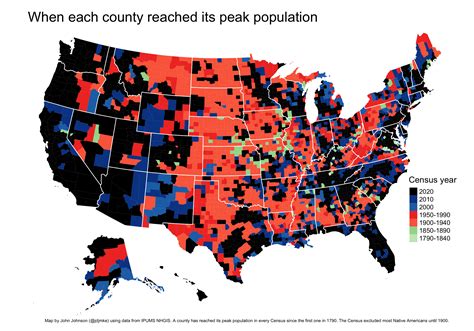Population Of United States 1960

The United States has experienced significant population growth over the decades, with each census period revealing shifts in demographic trends. As of the 1960 United States Census, conducted on April 1, 1960, the population of the United States was recorded at approximately 179,323,175. This figure marked a substantial increase from the 1950 census, which reported a population of about 151,325,798, indicating a growth rate of about 18.5% over the decade.
This period of growth was not isolated but rather part of a broader trend of population expansion in the United States. The post-World War II era, often referred to as the "baby boom" period, saw a significant surge in birth rates, contributing to the rapid population increase. Factors such as improved healthcare, increased life expectancy, and changes in societal norms also played crucial roles in this demographic shift.
Key Points
- The population of the United States as of the 1960 census was approximately 179,323,175.
- This represented an 18.5% increase from the 1950 census population of about 151,325,798.
- The post-World War II era, known for the "baby boom," was a significant contributor to this population growth.
- Improved healthcare, increased life expectancy, and societal changes also influenced the population increase.
- Understanding the 1960 population provides insight into the demographic trends and societal shifts of the time.
Demographic Shifts and Trends

The 1960 census not only provided a snapshot of the population size but also shed light on various demographic shifts and trends. For instance, there were notable changes in population distribution across different regions of the country. The Northeast and Midwest, traditionally industrial hubs, experienced slower growth rates compared to the South and West, which were attracting new residents due to their burgeoning economies and more favorable climates.
Urbanization and Migration Patterns
A significant aspect of the demographic landscape in 1960 was the ongoing process of urbanization. Many Americans were moving from rural areas to cities in search of employment opportunities, better living standards, and access to amenities. This migration contributed to the growth of metropolitan areas, with cities like New York, Los Angeles, and Chicago experiencing substantial population increases. The urban population was approximately 125,319,000, representing about 69.8% of the total population, highlighting the trend towards urban living.
| Category | Population Figures |
|---|---|
| Total Population | 179,323,175 |
| Urban Population | 125,319,000 |
| Rural Population | 54,004,175 |

Implications and Legacy

The population growth and demographic shifts identified in the 1960 census had significant implications for various aspects of American society. From a policy perspective, the increased population and changes in distribution necessitated adjustments in resource allocation, infrastructure development, and social services. The baby boom generation, in particular, would go on to influence cultural, economic, and political landscapes for decades to come, shaping the course of American history.
The legacy of the 1960 census can also be seen in the advancements it spurred in demographic analysis and population studies. The data collected during this period contributed to a deeper understanding of demographic trends, informing research and policy decisions that would impact future generations. As the United States continues to evolve demographically, the insights gained from past censuses, including that of 1960, remain invaluable for navigating the complexities of a changing population.
What was the total population of the United States according to the 1960 census?
+The total population of the United States as recorded by the 1960 census was approximately 179,323,175.
What factors contributed to the population growth between the 1950 and 1960 censuses?
+The population growth between the 1950 and 1960 censuses can be attributed to several factors, including the post-World War II baby boom, improvements in healthcare, increased life expectancy, and changes in societal norms.
How did urbanization affect the population distribution in the United States during this period?
+Urbanization led to a significant increase in the urban population, with many Americans moving from rural areas to cities for better job opportunities, living standards, and access to amenities. This resulted in substantial growth in metropolitan areas, with approximately 69.8% of the population living in urban settings by 1960.
In conclusion, the 1960 United States Census provides a pivotal snapshot of the country’s demographic landscape at a time of significant social, economic, and political change. The insights gained from this census continue to inform our understanding of population dynamics, urbanization, and the complex interplay of factors that shape the demographic trends of a nation. As we look to the future, the lessons learned from past demographic shifts will be crucial in navigating the challenges and opportunities presented by an evolving population.



